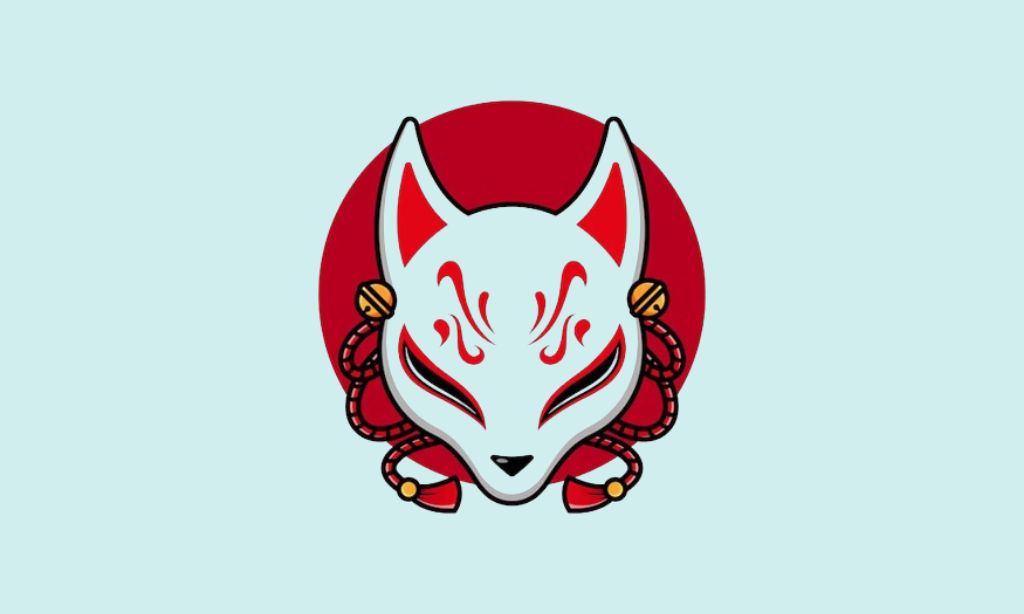Have you ever gazed at a kitsune mask or heard tales of the mysterious fox spirits in Japanese folklore and wondered about the secrets behind their mystical markings? The kitsune markings holds a prominent place in Japan’s cultural heritage, yet their significance can be as elusive as the creatures themselves.
From awe-inspiring powers to deep-rooted symbolism, these celestial beings captivate our imagination but leave many unanswered questions about their true nature.
One intriguing fact is that kitsune are said to have multiple tails—up to nine—that signify their age, wisdom, and strength. Imagine living for hundreds or even thousands of years; each century lived grants these spirits an additional tail, marking them as venerable messengers of the divine.
This article will unravel the mysteries surrounding kitsune types and markings, providing insight into what they mean and why they’re so integral to Japanese history. As you keep reading, prepare to embark on a journey through time and myth, where ancient legends come alive!
Understanding the Kitsune in Japanese Folklore
Kitsune are revered across Japan, weaving together the spiritual and the magical. They serve Inari Okami, the Shinto god of rice, fertility, and prosperity. These fox spirits guard Inari shrines and receive offerings from people hoping for blessings.
Kitsune possesses the power to change shapes. Often, they transform into beautiful women or old men with astounding ease. Their abilities reflect their wisdom and connection to the spiritual world.
Legends tell stories of kitsune interacting with humans as messengers or tricksters. For those who show respect and kindness, a kitsune might bring good luck or ward off bad spirits.
Yet anyone crossing a kitsune could face cunning pranks or misfortune as punishment for their actions. There is such a strong belief in these creatures that it has given rise to its own term, kitsunetsuki, which describes the condition of having a fox spirit possess you.
Symbolism of Kitsune Markings

Kitsune markings tell a story of mystical powers and life forces in Japanese culture. Each marking on the kitsune’s fur holds deep symbolism, often tied to Shinto religion and spiritual beliefs.
Some say these patterns are signs of a kitsune’s wisdom and age—the more complex, the wiser the fox spirit.
White patches might suggest purity or a connection to Inari Ōkami, the deity of the rice harvest season. Black markings can mean mystique or protection against bad luck. Red streaks often show strong supernatural powers or signal anger from gods towards mortals who have strayed.
Believers look for these symbols as messages from beyond our world—a bridge between humans and spirits that teaches respect for nature’s hidden forces.
Types of Kitsune and their Significance
Delve into the mystical realm where kitsune types, from the heavenly Tengoku to the enigmatic Jikan, reveal unique traits and roles within Japanese folklore—a tapestry interwoven with spiritual symbolism waiting to be unraveled by those keen on uncovering ancient secrets.
Tengoku Kitsune
Tengoku Kitsune stands as a beacon of wisdom and enlightenment in Japanese folklore. These celestial beings are depicted with pure white fur and have six tails, each one a symbol of their deep knowledge.
They hold a special place in mythology as the first kitsune to reach full enlightenment.
With their white coats shining, Tengoku Kitsune serve as guides for those seeking spiritual understanding. Their connection to wisdom makes them respected figures within the Shinto faith and beyond.
Many tales feature these majestic creatures sharing insights with humans or aiding them on paths to greater self-awareness.
Kukan Kitsune
Kukan Kitsune stands out among the mystical fox spirits of Japanese folklore. They wield the power to bend space, making them master shapeshifters. Imagine being able to slip between places in the blink of an eye—that’s what these clever creatures can do! Their abilities are beyond impressive and have sparked countless stories throughout history.
Fans of Kukan Kitsune love their sneaky charm and space-twisting antics. These kitsunes are like magicians, always keeping you guessing with their next move. They’re not just about mystery, though; they hold a special place in tales where skill and cunning are prized above all else.
Kaze Kitsune
Kaze Kitsune are special foxes linked with the wind element in Japanese folklore. Their fur bears unique wind markings, a sign of their connection to the breezy realms. People believe these creatures carry good luck and can perform impressive wind-based magic.
Their colors may vary, but what sets them apart is their mastery over gusts and gales.
These foxes hold an important place in stories and beliefs about nature’s spirits. Farmers especially look up to Kaze Kitsune, hoping for favorable winds for their crops. They see these foxes as helpful spirits that keep bad weather away.
Rich tales surround these mystical beings, making them beloved figures in legends and art across Japan.
Seishin kitsune
Seishin kitsune are known for their ability to change into humans. They have strong magic powers. These fox spirits connect deeply with the Shinto religion. They honor Inari, the kami of things like foxes and rice.
People say seishin kitsune helps bring good harvests and fertility. During special times, you might see them in Shinto rituals or prayers. Their link with sake, tea, and rice is a big deal in Japanese traditions.
Kasai kitsune
Kasai kitsune are fiery beings in Japanese folklore, known for their ability to control flames. These fire foxes stand out as powerful creatures with a mystical connection to fire.
Like their elemental namesake, they’re linked to warmth and destruction, able to create or extinguish fires at will. Often depicted as clever and intense, Kasai kitsune appear both fearsome and fascinating in tales where they wield their flaming powers.
Living in colonies allows these foxes to thrive across various habitats due to their omnivorous nature. This adaptation makes them unique among the mythical fox creatures of Japan.
Kasai kitsunes’ social structure reflects that of actual foxes but is steeped in magical lore which differentiates them from other types of spirit animals. Their communal lifestyle also suggests a complex society within the realm of spirits, one where fire isn’t just an element—it’s part of who they are.
Chikyu kitsune
Chikyu Kitsune holds power over the earth, weaving magic that can summon quakes or fierce storms. Their clever nature lets them play tricks, even turning unsuspecting folks into kitsunes too.
They stand out among their kind with unique markings tied to their earth-shaping abilities. Earthly forces bend at their command, and they remind us of the deep links between Kitsune lore and the natural world.
These fox spirits wield influence over humans and are essential to Japanese mythology’s tapestry. Recognizing a Chikyu Kitsune is all about spotting those special signs that show their connection to powerful natural events.
Their role in stories highlights our fascination with beings that straddle human life and wild phenomena, forging a bridge between myth and reality through enchanting tales of shape-shifting tricksters linked to land itself.
Kawa kitsune
The Kawa Kitsune is a special type of fox spirit in Japanese folklore. Linked to rivers and waterways, these kitsunes have powers that relate to water elements. They are known to help with fishing or provide good luck for those who work on the water.
Often, they appear as guardians of riverbanks and can play tricks on people who disrespect their waters.
These mystical creatures may also guide souls across rivers to the afterlife. Legends tell of Kawa kitsunes assisting lost spirits, ensuring they find peace. Unlike some of their more fiery counterparts, these water foxes are seen as gentle beings, unless provoked by harm to their beloved rivers.
Respect for nature and the Kawa Kitsune’s domain is a theme woven throughout tales involving these serene yet powerful entities.
Umi Kitsune
Umi Kitsune are seen as the most powerful among the Kitsune, shrouded in mystique and awe. They hold vast magical abilities, can heal injuries with a touch, and create beautiful art that captivates all who see it.
Legends say they can command the seas and bring peace to troubled waters. Their presence is a sign of deep wisdom and extraordinary power.
People whisper stories about Umi Kitsune’s enchanting songs that echo across ocean waves. With every note, they weave spells of protection for sailors and fisherfolk. These sea foxes are guardians of coastal villages, revered for their kindness and artistic gifts.
If you ever feel a gentle sea breeze or find an intricately carved seashell on the shore, some believe it might be a gift from an Umi Kitsune.
Yama kitsune
Yama Kitsune holds the secrets of the mountainous terrain. They are seen as guardians, deeply connected to nature and its ancient wisdom. People believe these fox spirits can control forests and influence wildlife.
The power of yama kitsune stretches far into Japanese legends, where their presence in stories often symbolizes strength and mystery.
These mountain foxes carry a mystical aura about them. As part of Japanese folklore, they remind us that every rock, tree, and river may hold a spirit within it. Yama kitsune represent the vibrant life force found high in the hills where people seldom roam—an untamed energy only these revered creatures masterfully wield.
Mori kitsune
Mori kitsune hold a special place in Japanese folklore. They reside in a forest, amidst the unspoiled beauty of nature. These fox spirits are known for their wisdom and knowledge of the woods.
People believe that if you treat them with respect, they can offer guidance and even healing powers.
Each Mori kitsune has unique abilities that set them apart from other types of Kitsune. Their deep connection to the woodland environment allows them to communicate with plants and animals alike.
They move silently among the trees, masters of their hidden realm, always ready to lend their support to those who honor the forest as they do.
Sanda kitsune
Sanda Kitsune carries a unique charm in the world of mythical foxes. They sport black and white fur, which people often see as symbols of luck. In Japanese tales, these creatures are smart and crafty.
Some stories say they bring good fortune, while others believe sanda kitsune can be a sign of bad luck too.
They play roles in many kitsunetsuki myths—tales where foxes possess humans. These stories show how deeply sanda kitsune are woven into Japanese folklore. Their intelligence is legendary, marking them as standout characters among their colorful kin.
People still talk about these mysterious foxes today, showing how timeless the legends are.
Jikan Kitsune
Jikan Kitsune hold a special place in the mystical world of Japanese folklore. Known for their connection to time, these fox spirits are linked closely with Shinto beliefs and the kami of agriculture and prosperity.
They’re said to have powers that stretch over the fabric of time itself, allowing them to glimpse into the past or twist future events. Their abilities don’t stop there; Jikan Kitsune can also dive into minds, uncovering thoughts and secrets hidden within.
With such profound capabilities, Jikan Kitsune are revered as powerful spiritual entities. People fascinated by these creatures often see them as guardians against misfortune, hoping for blessings in fertility or a bountiful harvest season.
In stories and myths passed down through generations, these kitsune emerge as wise beings offering guidance or serving as omens for significant life changes.
Ongaku Kitsune
Picture a fox with the power to turn into musical instruments. This is the Ongaku Kitsune, a magical creature linked to music and sound in Japanese tales. They’re easy to spot with their shiny golden tails that seem to dance with each note they play.
The Ongaku Kitsune can weave enchanting melodies, using this gift to spread joy or even communicate messages through song. Legends say these foxes create tunes that can touch the soul, making them unique among their mystical kin.
With every chord they strike, an Ongaku Kitsune shares a bit of its magic with the world.
The Nine-Tailed Kitsune: Meaning and Representation
A nine-tailed kite stands at the peak of fox spirits, wielding immense wisdom and magical powers. Gaining a tail for every century lived, these mystical creatures symbolize longevity and profound knowledge.
They are often seen as guardians or omens of good fortune in Japanese culture. A kitsune with nine tails also represents the full cycle of growth a kitsune can achieve, embodying ultimate enlightenment.
In tales and art, the nine-tailed fox serves as both protector and trickster. People believe it can see everything happening in the world with its many eyes and ears. Through its shapeshifting abilities, it interacts with humans—sometimes helping them, other times leading them into mischief.
The presence of this mighty entity highlights a deep respect for forces beyond human understanding within traditional folklore.
The Kitsune Mask
Delve into the enigmatic world of the Kitsune mask, where history intertwines with symbolism to unveil a tapestry of cultural significance that still resonates in modern aesthetics—discover more about its role beyond the facade.
History and Symbolism
Kitsune masks have a deep history in Japan, woven into the fabric of its cultural and religious life. They first appeared as part of rituals linked to Shintoism, the indigenous faith of the Japanese people.
These masks embody the fox deity’s complex nature, from being wise messengers for the gods to mischievous spirits roaming the earthly realm. People wear them during special occasions and festivals, acknowledging that kitsune are more than just myths; they are integral to understanding divine messages and favor.
Foxes hold a special place in Japanese symbolism as creatures with dual personalities—both good and bad, showing us different faces at different times. The mask captures this duality perfectly: one side is often smiling, while the other might be fierce or solemn.
During ceremonies like bean-throwing or while honoring Inari-sama, donning these masks reinforces respect for guardian spirits and celebrates their role across seasons—from ensuring bountiful rice harvests to guarding sacred places.
Through each graceful dance or ritualistic offering behind a kitsune mask lies an ancient story retold—a connection between humans and spiritual realms maintained for generations.
The Kitsune Mask in Anime
Anime fans often see characters wearing kitsune masks. These masks have fox features and are popular in many stories. In anime, they can mean a character has secret powers or a hidden identity.
They add mystery to the story.
The kitsune mask popped up in western culture mainly because of anime shows. It made people curious about this piece of Japanese folklore. Some well-known anime, like “Naruto,” feature these fox spirits as major parts of the plot.
Characters with kitsune masks are usually powerful and wise, catching viewers’ attention with their cool design and deep roots in myth.
The Kitsune Mask Tattoo
The Kitsune mask tattoo carries a mix of meanings. In some circles, it’s linked with the Yakuza, marking those who live on the fringes of society. Yet for others, this ink can symbolize cunning or serve as a guide to prosperity and good luck.
It’s more than just art; it’s a story etched in skin that taps into deep traditions.
These tattoos were once taboo in Japanese culture—a bold statement not made lightly. Today, they’re popular beyond Japan’s borders, blending cultural tales with personal significance.
People choose these designs to connect with folklore or their inner fox spirit, navigating life’s twists and turns with mythical flair.
Conclusion
Kitsune markings hold deep stories from Japanese folklore. They tell tales of power, mystery, and the spiritual world. Every mark reveals something special about its fox bearer. From protective deities to mischievous spirits, these creatures capture our imagination.
Understanding their symbols connects us with a rich cultural heritage that thrives even today.




![How Much is Lil Baby’s Net Worth in 2024 [Latest Info] Lil Baby Net Worth](https://www.wariat.org/wp-content/uploads/2024/03/Lil-Baby-Net-Worth-150x150.jpg)
![Rob Lowe Net Worth Speculation in 2024 [Comparative Analysis] Rob Lowe Net Worth](https://www.wariat.org/wp-content/uploads/2024/03/Rob-Lowe-Net-Worth-150x150.jpg)

